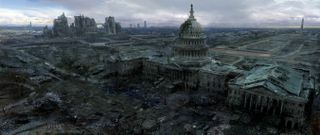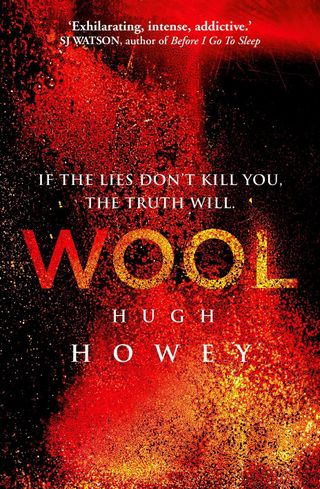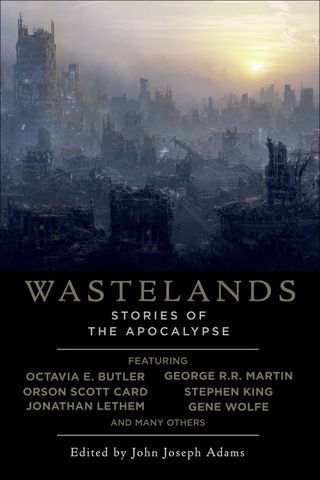If you like Fallout 3 you'll also like...

Fallout 3’s bleak opening doesn’t give much away in terms of the post-apocalyptic world waiting for you outside Vault 101’s monolithic doors, but its vision of a ruined U.S. capitol remains one the most vividly-imagined RPG playgrounds of the what-might-have-been. We find a once great city that’s witnessed its power and glory literally vaporized, leaving behind sky, sand and sewers. When I think about Fallout 3, I’m immediately transported to a realm of alternate future histories, desperate urban decay, and unpredictable technology. It’s my kind of town.
And yet Fallout 3 also gets better each time I return, because I arrive from a new, often unexpected, direction. Games like Fallout 3—by which I mean, the best games—both draw on and feedback into other works of pop culture. Whenever I come across another brilliantly realized nuclear dystopia, I find myself itching to head back to Bethseda’s irradiated sandbox with a fresh set of eyes. In this, the first of our new ‘If you love...’ series, I’m going to pick out great books, movies and more which share some of Fallout 3’s mutated DNA, which I think you’ll enjoy and might inspire you to revisit the game.
Wool, by Hugh Howey

Hugh Howey’s Wool is great at modelling the psychological chaos of life after an apocalypse. Part one of the sprawling Silo series begins with the mystery of confinement inside an underground community, where history and memory are uncertain and dangerous concepts. Dissent is illegal and punished in the harshest way imaginable for such an insular society—you get a one-way ticket to the surface.
Book one of Wool struck me as especially poignant in the way it played with time and intimacy between partners—in this case a man and his wife. The way in which honesty, tradition, and paranoia converge to force difficult decisions also reminds me of Fallout 3’s world, where every choice seems to be a different shade of grey. As in Fallout, the “right” decisions in Wool aren’t always easy because the characters’ view of themselves—and the world they inhabit—isn’t clear at all.
If you want to get a taste of it, part one of Wool is available as a free ebook, readable on a Kindle device or a Kindle app in your browser. For those of you who want to dive right into act one of the Silo series, the complete, five-book Wool collection is also compiled in a handy omnibus edition.
Yves Marchand & Romain Meffre: The Ruins of Detroit
Even if we find ourselves revisiting the atomic wasteland of Fallout 3’s 2277 Washington D.C. again and again, the 21st century has a few wastelands of its own to explore. In the case of another iconic American city, Detroit, its current devastation has less to do with radiation and more to do with a particular brand of economic warfare. Detroit’s struggles have been chronicled by many artists and journalists in recent years, but few have captured the empty spaces of Motor City quite like the photographers Yves Marchand and Romain Meffre.
I’ve embedded a video slideshow of some of their work above compiled by YouTube user Erik Collett. It’s similar to photography which is also featured here at The Guardian website. The photographers’ work is strangely reminiscent of another great piece I came across recently, namely science writer George Johnson’s story on nuclear tourism inside the irradiated zone surrounding Chernobyl. Stalkers are real, and for a price, they’re happy to arrange tours of neighboring Pripyat. Just don’t eat the mushrooms.
PC Gamer Newsletter
Sign up to get the best content of the week, and great gaming deals, as picked by the editors.
A hardbound edition of Marchand and Meffre’s complete look at Detroit’s urban decay is available here.
Tag 26, director and writer Andreas Samland
Andreas Samland’s 2003 short film holds nothing back. Tag 26 (Day 26) deals directly with the topic of survival in a way that feels both unique and familiar. It starts with a simple premise—two wanderers need fuel for their vehicle. But what that fuel will ultimately cost them speaks to the horror built into the post-apocalyptic genre. What would you do in their place?
In a 2003 interview, the director reveals that he drew inspiration from Andrei Tarkovsky’s Stalker and says he was able to complete the film for just 7,000 euros. Hat tip to Luke “shinkicker” Hinds for the original tip on this brilliant film.
Wastelands: Stories of the Apocalypse, edited by John Joseph Adams

By now a classic example of the renewed focus on anthologies in science fiction and fantasy publishing since the turn of the millenium, editor John Joseph Adams’s 2008 collection is a fantastic introduction to post-apocalyptic writing over the last four decades. It’s full of dystopian takes on dark passages, empty towns, and religious salvation among the ruins. I call this the Fallout 3 trifecta. And since every entry in the collection is a standalone story you can experience in one sitting, it’s perfect for those moments when we want to take a trip to the end of the world, but maybe not stay there too long.
Wastelands includes contributions by Stephen King, George R.R. Martin, and Orson Scott Card, among many others. And with the spectacular success of Martin’s fantasy writing, it’s easy to forget how masterful a stylist he is in other genres. His take on the post-apocalyptic in “Dark, Dark, Were the Tunnels” is no exception. In it, a scout named Greel encounters something he’s never seen before in all his subterranean wanderings—a tunnel filled with light.
Another favorite of mine is Elizabeth Bear’s “And the Deep Blue Sea.” We follow a messenger as she attempts a run from Phoenix to Sacramento in eight hours through an American West devastated by nuclear war. But fuel is scarce and radiation zones are everywhere.
Stephen King offers an unusual take on the apocalypse in “The End of the Whole Mess,” which opens the collection. It introduces us to a writer documenting the last hours of his life. For reasons that will become clear, as the world disintegrates, so does his language.
While the book contains reprints of previously published stories, the pacing and tone that Adams achieves through his selection makes for a great volume. Wastelands also includes a bibliography of post-apocalyptic literature for suggested further reading. And if that doesn’t satisfy your dystopian thirst, a second collection from Adams, Wastelands 2, released this month.
Tears of Steel, director and writer Ian Hubert
One of my favorite aspects of Fallout 3 is its embrace of unreliable, often murderous technology. Robots, when sufficiently convinced through proper terminal hacking, can be helpful allies against bug infestations and unpleasant raiders. Or they might kill you. In Tears of Steel, a group of scientists attempt a special kind of hack in order to save themselves in a future full of machines gone mad. The short film, embedded above, is a product of the Blender Institute and was filmed in the Netherlands.
Let us know in the comments what your favorite artistic Fallout 3 bedfellows are, and also help us pick the next game for the “If you like…” treatment.
Most Popular





